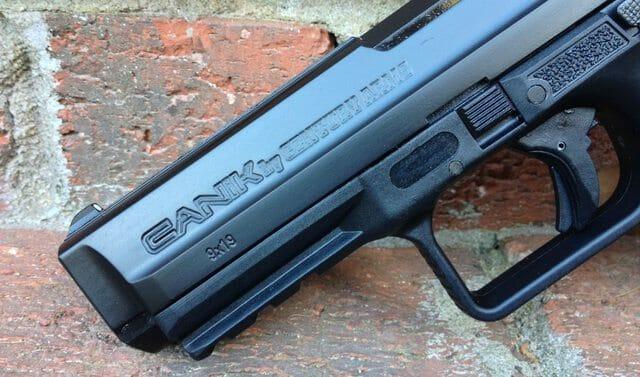Although popular gun culture in the U.S. doesn’t pay much attention, Turkey has long been a major producer of firearms, mostly for military use.
Historically, the country’s civilian handgun production included a 1911-based firearm made by a company once known as Canik 55. My sources say the brand is properly pronounced “JOHN-ick,” though I say it like the graduate of childhood phonics education that I am.
No matter how you say it, Canik eventually lost the “55” in their name, and has since claimed a stake in the big leagues of modern pistol production. The TP9 SA, their first striker-fired 9mm semiauto that I’m aware of in the U.S. market, became my choice of range gun four years ago. More than 6,000 rounds and with a few other Canik product experiences later, it remains my favorite handgun.
The TP9 SA emerged with apparent design influence from the Walther P99, but with an American magazine release. Canik wisely kept a low bore axis (hence low recoil) design, simple disassembly, and modular grip panels which are included with each gun. Other handy features include an accessory rail, lanyard hole in the grip, a highly visible three-dot sight system with a subtle vertical highlight on the rear sight, and a Serpa-style Kydex holster that can be used as a paddle or belt-borne. Color choices include black and desert tan. Magazines, now readily available for a reasonable price, hold an impressive 18 rounds in the same space a Glock mag holds 17.
The Self-Defense Weapon That Doesn’t Require A Firearms License!
There’s a bit of weirdness in the original TP9, in the form of a striker decocker located on the top of the slide just in front of the rear sight. Canik’s rationale was to allow for the striker to be released without pressing the trigger, as in preparation for cleaning. It’s an unnecessary, but innocuous, device that has never caused a problem, nor have I ever used it, in the years I’ve used the gun.
Other than fit for a variety of hands, which is becoming the norm for new polymer-lower pistols, is the quality of the TP9 trigger. Its moderate uptake, smooth break, and relatively short, crisp reset are as good as that on my HK VP9, which retails for twice the price. Though a great trigger is just part of what makes a satisfying choice of firearm, there’s no denying that this one is superb in its class.
The Downside
A downside does exist to the first couple years of production models of TP9 SA and its first successor, the TP9 SF. I have owned both. This issue is related to the trigger I just described as outstanding. After having cycled in excess of 5,000 rounds, the striker on my SA model was no longer functional. The trigger would activate, with no corresponding activity by the striker. The then-new (2015 model) SF worked well, but its trigger would reset in two subtle stages.
As I was the original owner and had registered the warranties on both pistols, Century Arms, the U.S. importer/distributor, agreed to fix them. I was given an ominous reminder upon sending them that repairs may take up to six weeks. In reality, both guns were returned in just nine days. Though the repairs were done quickly and well, Century’s customer service left much to be desired in terms of communication; they’re email-based only and managed to confuse the guns’ serial numbers during the repair process, finally creating an accusation that I’d confused the frames and slides. That’s hardly possible, especially when the SA has significant visible wear.
Despite the bizarre customer service experience, the guns were returned fully repaired and with the outstanding triggers I have by now come to love. It was after the repair experience that I learned that premature striker failures are common among TP9s made earlier than 2016. A gunsmith who knows the TP9 SA well showed me the seemingly minor difference in construction between the trigger on my repaired handgun and the original. Unfortunately, it was on a range setting where I couldn’t get a photo or take notes, and the names of the involved parts now escape memory. He bemoaned the fact that Century Arms doesn’t sell repair parts, nor are non-original owners or owners who’ve had their pistol for more than a year offered free repairs, though the premature wear is not the user’s doing.
http://www.offthegridnews.com/self-defense/it-may-be-the-best-pisto...

